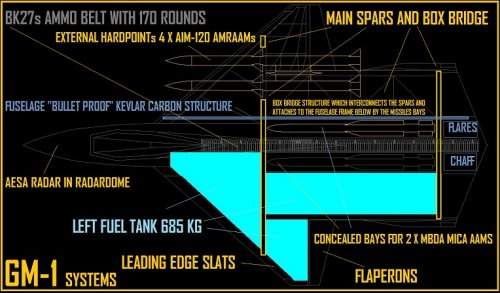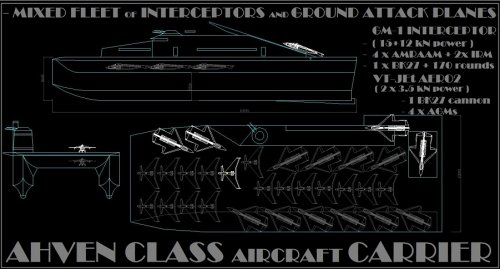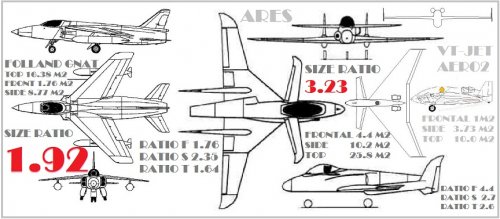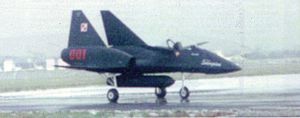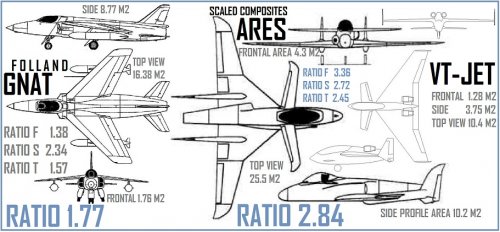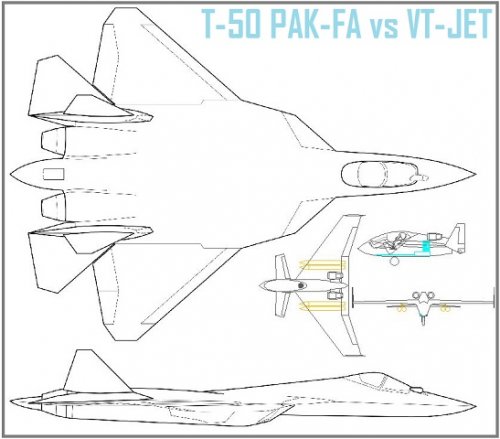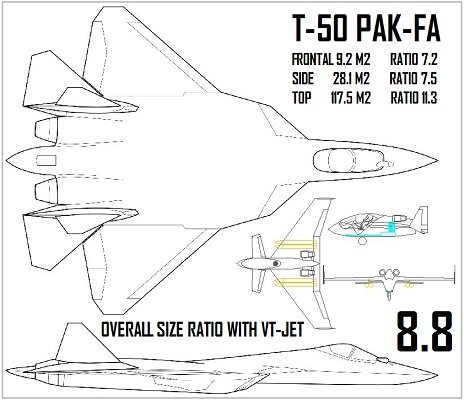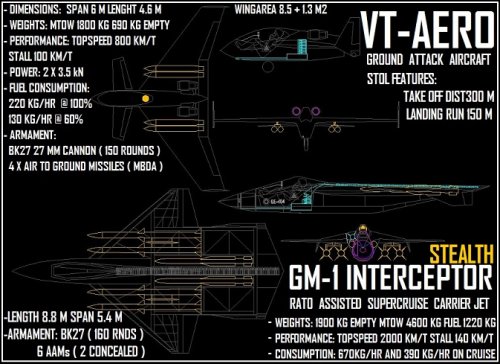Kryptid said:
If you want me to go into more detail about my criticisms, I will. This will probably end up being quite a lengthy post, so be prepared to read a lot.
First of all, let’s take a look at your claims:
I'd claim that a really small stealth fighter is totally invisible ( to any radar ) and thus more effective in intercepting.
1.I can tell you that this claim is false. There is no such thing as an aircraft being totally invisible to all radars. There will always be returns, even if they are small. The only way you could make an aircraft have an RCS of zero would be to use some as-of-yet undiscovered RAM which absorbs 100% of all incident radio waves or to use some material (such as metamaterials) which can divert all of the radiation around the aircraft. It will probably be quite awhile before we learn how to properly use metamaterials in such a way.
Even if you could completely absorb all of the radio waves. SpudmanWP has already pointed out how an aircraft flying above your aircraft can detect it by finding a fast-moving “black hole” on the radar screen. I have yet to see you explain how your aircraft can avoid being detected in this manner.
Well there is an other point...if the plane is small and can fly slow so that no EODAS can detect it or IRST ( no heat signature and 1/5th of the F-22 RCS ) it can always come close enuf with superior clim rate to use the cannon...not necessasily GSH 300 but lets say GAU-22 or BK27.
2. If your aircraft is powered by a jet engine, then it must have a heat signature. That’s how they make their thrust. I’m not sure if you are aware of this, but EO DAS doesn’t see heat in the same way that the alien from the movie Predator does. It can actually form images not too far off from what the human eye can see. Even if an object is not hot, it can reflect infrared radiation from the Sun and from other sources. If the pilot can see your aircraft, then there’s a good chance that EO DAS can as well.
Even if your engine is somehow magically able to make its exhaust temperature the same as the surrounding air, your RATOs will produce quite a prominent heat signature when they are fired up. Rockets aren’t exactly known for having low-temperature exhaust, you know.
My plane is in the level of F-22 in RCS except the rudders that are much smaller and underside.
3.How do you know its RCS? I hope you didn’t simply guess it.
So after a days repair the 10 million usd plane is up in the air and the pilot as well.
4.Did you calculate that price or did you guess it? Let’s not forget that the unit price of an aircraft is strongly affected by the total number of aircraft built as well as any delays that may be introduced during R&D among other things. Simply knowing the aircraft’s design is not enough to calculate its full price.
But like i said this doesn't leave a hole behind with rcs of size of a pin head.
5.So your aircraft started with an RCS of zero, then “in the level of F-22” and now it’s on the order of a pinhead? Sounds like your knowledge of its RCS is rather shaky.
This is not intercontinental with 1500 km combat range...and ferryrange 3000 km. 4200 km with 2 x 450 l drop tanks ( sans 4 AMRAAMs )
6.Again, did you calculate those values or guess them?
Of course this does produce some heat
7.Initially you said that it had no heat signature. Please try to stay consistent.
And aircraft doing sneaky approach or loiter at 300 mph definitely won't be producing friction with its airframe. Why would combat aeroplane always have to go mach 2 + ?...that is silly and dumb.
8. Once you fire up those RATOs, your heat signature will become significant. I pointed this out earlier.
You are 100% correct that this AC does not have better or even same RCS than a F-22 has.
9.So you’ve changed your mind about its RCS yet again?
I have said several times following here...if it had same splendid RCS form and material...its size would make it far more stealthy....do you agree ?
10.I’m afraid I do not agree. The RCS of an aircraft changes with the frequency of radar used to detect it. It is actually important to make the edges of the aircraft significantly larger than the wavelengths of the radar it is supposed to stealthy against. If the edges are too small, they actually harm the aircraft’s stealth properties. This was somewhat pointed out earlier in the thread when the B-2’s large size was used as an example of one advantage it has in this regard. I have read elsewhere (and may try to dig the quote up later) that the F-117’s RCS would not have increased if it had been made as large as a bomber.
I have several totally secret aspects in this craft that actually make this happen ( that I haven't revealed at KP site or here ) and I doubt anyone can make a design that has this much punch and mach 2 capability even on paper in this size ( it would be interesting to see if someone could....perhaps Burt Rutan or Jim Bede ). I have worked continuosly 7 years to make this happen ( even to this stage )...making enermous amount of inventions...to save in size, weight and fuel...certainly I don't know everything.
11.And why would you feel the need to keep secrets about this design? Do you expect to actually sell it someday? To claim that you have some kind of “secret” which makes your design better than one anyone else can produce is highly suspect to say the least. This is especially true because you admit to not having actually made any test models of the plane.
Because at low altitude very few aeroplanes actually operate much above mach 1.0 ..the air is just so thick...trying to keep the drag minimum might make possible to fly supercruise with extremely small engine
12. How do you expect your engine to be highly efficient during subsonic loiter, capable of a 35 km ceiling and be supercruise capable? That’s quite the magic little engine you have there. If you are using the RATOs to go supersonic, that is not the same as supercruise.
The plane is small too and STOL most of all.
13.Unless you’ve calculated the take-off and landing roll, you don’t know that. As a matter of fact, Lockheed Martin found it difficult to meet both the STOL and supercruise requirements simultaneously during the design phase of the ATF. STOL requires high lift at low speed and supercruise requires low drag at high speed. How do you propose to resolve this problem?
To be able to do what I am doing you have to first build 100 models..invent new kinda millions selling kites..lead kids in daytime with R/C models and discuss these things about 15 years with experts...and design new concepts every day about 4-5 hours until 2 am in the morning.
14. Doing extensive research as a hobby is no substitute for having real-world experience as a professional designer.
15.Okay, now for me to look at the design itself:
You say that you know a lot about stealth, but I can see some obvious problems with your design in regards to RCS reduction. Look at the control surfaces. Unlike on most other aircraft, the hinge lines of the control surfaces on a stealth aircraft are usually of a constant chord so that they are planform aligned with the other surfaces of the aircraft. In your design, The hinge lines are not aligned with the trailing edges of the control surfaces and are in fact perpendicular to the centerline of the aircraft. That is the worst possible arrangement for a stealth aircraft. Also, the trailing edge of the elevators don’t seem to align with either the leading edge or trailing edge of the wing. That will carry an RCS penalty as well.
16.Take a look at the vertical tails. What is the tail volume coefficient for those verticals? They look to be far too small to properly stabilize the aircraft. Compare them with other supersonic interceptors such as the MiG-25 and F-106. They have rather large tails. You should make the tails larger on your aircraft as well.
17.Your drawing lacks important details. Where is the engine located in your design? I’m looking at the top view and I don’t see it. Where is the landing gear?
Kryptic I bet this site would not be what it is without you. My wife told me go to work but I choose to answer you really lenghty questions that seeked no answer from my previous posts..on the contrary you took them from contect randomly which is a "crime" in conversation as this is.
Anyway.
1. Several US planes are said to have a RCS of a ball bearing ( they can be size of beach ball you know ). But lets say it means a ball bearing used in a bicycle 4/4 mm. This is said to be size also in B-2 ( which is bigger than my aircraft carrier or similar ). Also F-35 seems to posses this similar size and F-22. Then there is info that F-35 has in fact much lesser RCS capabilities than F-22...and F-22 also having bigger RCS figure than B-2. I assume the latter is correct...because I think I know where it is based on. B-2 has engine inlets closed from beneath ( or placed above ) and has no rudders. Also it has form that gives back very little radar signals...and material..some industrial diamond coating.
What I have claimed is that when this plane ( GM-1 ) gets all corners shaped like YF-23 or B-2 and similar coating its radar signature becomes nearly invisible. It has to become since this craft is really 1/20th in size of a B-2. I mean now the RCS size not heat signature..we get into that later.
I don't believe this is a black hole either.
2. SpudmanWP did indeed bring about the heat signature. I bet this craft when flying above a large frozen lake has a bigger heat signature than flying above the earth surface. A tin roof can heat up 100 C degrees. I assume that there is somekinda setting in heat seaking missiles that they dont lock into everything that has some heat. This craft heat source stays below that aperture when scanned from above the plane.
3. Angles are better to deflect the radar beams away from radar. Also like I said 20 times smaller.
4. Yes I calculated the price bit by bit . R&D for Space Ship One was 25 million USD. This is small plane with simplified systems and cannot cost much more ..100 mio max.
5. I know the ballpark and I am not the divine thruth in RCS, but I can think and draw conclusions from data I read and see. I have worked with radars.
6. I calculated them when I know the SFC and fuel tank dimensions.
7. I stick to that...IT HAS NO HEAT SIGNATURE when it comes to detection with any instrument in normal environment from a distance. It has the needed heat to move the plane forward yes.
8. That is correct...once the plane has maneuvered to position the foe radar cannot detect it with RATOS engaged or is too late for it ( to initiate counter measures ) the GM pilot uses the boosters to get into position to launch missiles ( or just cannon ) to a bigger less stealthy target. This can also mean other tactical maneuvers where the RATO can be used in several manners. It could be used to ge the plane into position fast in 22 km altitude for patrolling.
9. No smaller plane has more stealthy features than a plane size of a tenniscourt. RCS is not all that there is to it. RCS is just one tiny fragment of it.
10. F-117 was easy bite for older radars. We don't have to agree do we.
11. Why do we have air force ? Think about it for a while ( our AF is 100% defensive ). I will test it pretty soon..and preparing an R/C model for it.
12. Treshold for going supersonic is high..RATO helps here..punching it into supersonic where it can stay on supercruise on its own.
13. I started a thread at local FlightForum around 2007 to solve this...to have both edges of the envelope extented in a small plane. It has given good results. I mean my research.
14. Not unless you really know what you are doing and evolve.
15. No but the solution saves lotsa weight and is insignificant in RCS...next to insignificant. Their size is big and their deflection is also thus minimal..unlike in heavy bricks that you refer as "the usual stealth aircraft".
16. B-2 has no tails. But this configuration is totally different from MIG-25 and others since this has mid mounted engine and a 2 piece wing with very short span..this plane coefficients are calculated in same way as others but since you don't know ( apparently ) which part here is tail and which is wing you cannot determ it from just eyeballing it. Besides it has two rudders..compare it to Me-110 and you get better idea.
17. These are the two secrets ( engine has thrust vectoring as well, simple but still ).
Anything else ?

